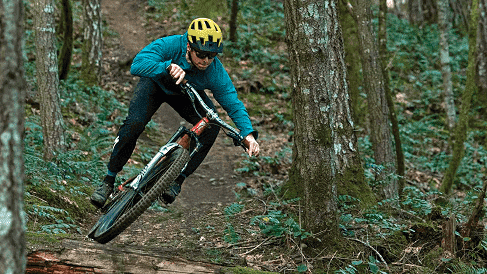A major innovation in recent years for the bicycle industry has undoubtedly been the mass use of carbon fiber in producing carbon hardtail bicycle components. Carbon began to be more widely used in the bicycle industry in the 1990s.
- Part 1: Carbon Hardtail Overview
- Part 2: Carbon Hardtail Advantages
- Part 3: Carbon Hardtail Classification And Introduction
- Part 4: Buying Guideline
Part 1: Carbon Hardtail Overview
Carbon hardtail mountain bikes are lighter, useful only when riding but also when transporting and carrying. Another advantage is that two bottles can fit on the frame. There will be no problem with taking enough liquids for proper hydration.
Carbon hardtail mountain bikes are among the most popular and most common bikes for amateur and professional mountain biking in varied terrain. With a spring-mounted only at the front and the proverbial “stiff tail,” carbon fiber hardtails provide adequate cushioning when riding over rough terrain. While it can also maintain high comfort on varied terrain and a better grip on the ground.
Origins of Carbon in the Cycling World
Carbon fiber, commonly known as carbon, is a fantastic material. It is not only extremely light but also extremely strong. The genesis of this material dates back to 1963 when it began to be used in aviation and by NASA. Since the whole technology and production was extremely (this word is very appropriate here) expensive, actually only these two industries used this technology. In later years, F1 teams became interested in carbon and saw a future in this system. In 1981 the McLaren team built the first car using carbon fiber.
Depending on the terrain for which they are dedicated, they differ in geometry and parameters of individual components. In many cases, models need to be strong enough to withstand the stresses of landing after jumping from great heights. This means that a full suspension Downhill bike will have a more forward wheel, and the shock travel will need to be much higher than on an XC bike.
Part 2: Carbon Hardtail Advantages
Carbon hardtail mountain bikes equipped with only a front shock are cheaper and more accessible than full-suspension models. You can choose between recreational and more advanced models. It’s easy to get started on an advanced MTB hardtail bike for just under $3,000. A new carbon Mtb hardtail bike is unlikely to do well at this price level – you’ll be hard-pressed to even find one.
Part 3: Carbon Hardtail Classification And Introduction
Construction of Mtb carbon hardtail bikes allows them to be used in very specific, demanding terrain. And they are created based on the front shock absorber universal bike, recreational, suitable for riding in any terrain.
Typical carbon hardtails are lighter and more durable than full-suspension bikes and offer much better maneuverability. Grip tailored to the needs of amateur and experienced riders. They are best suited for easy to intermediate trails, with bumps that don’t require maximum protection from the dual suspension level. Mtb hardtail carbon can be specialized or made for all-around riding. You’ll even find simple mountain touring bikes in hardtail versions, reflecting the nature of the first mountain bikes treated as all-purpose bikes just a dozen years ago.
The agility and riding dynamics offered by carbon fiber hardtail mountain bikes will depend on the specific geometry of the bike. The use of a single shock absorber at the front does not in any way interfere with the manufacturers’ ability to adapt the bike to dynamic descents or difficult climbs. A good power to pedal ratio ensures that hardtails are much easier to ride uphill and straight sections of a trail. This is why enduro and MTB hardtails are still much more popular with racers and recreational riders despite the popularity of full-suspension bikes.
Higher stiffness will be useful on lighter trails, where energy will not be dissipated, thanks to which you will ride faster. This feature is especially important on long climbs. It is much easier to find a full in high mountains, which will give you a rest on descents. But it also has its dark side – carbon hardtail Mtb will not be useful in the most difficult terrain.

Part 4: Buying Guideline
Hardtail mountain bikes on the market are increasingly discipline-specific pieces of cycling equipment designed to tackle the most challenging mountain trails. The simple construction of hardtail bikes has a shock absorber, mounted only at the front. It allows many changes to be made to the bike’s overall geometry to suit the rider’s requirements. Carbon hardtail enduro adapted to the toughest trails thanks to the high stroke of the front shock. Manufacturers stipulate up to 160 mm of travel. It ensures the confident handling of the bike on the biggest bumps, even at high-speed downhill.
Trail hardtails are touring bikes, less specialized than enduros but prepared for tough challenges. The best hardtail carbon mountain bikes are designed for dynamic riding on diverse mountain trails, focusing on trails with many climbs and descents. The strengths of trail hardtails are the front shocks with 110-140mm of travel and the durable brakes that give you the confidence to ride confidently on dynamic descents.
Hardtail e-bikes, depending on their geometry, can be used on gentle mountain trails and very demanding, bumpy trails or enduro trails. Apart from the perfectly developed geometry of a hardtail bike, the unquestionable advantage is the electric power supply, which makes it easier to conquer difficult climbs and prolongs the joy of riding without tiring.
Mtb hardtail carbon cross country XC have riding dynamics written into their nature. Everything here is built for high riding dynamics and easy cornering. With slightly less travel than enduro or trail bikes, CX bikes with straight handlebars, 80-100 mm of travel, a narrow saddle, and a light frame allow fast and dynamic cross-country riding.
Price
While it used to be all about descents, and fast descents at that, we couldn’t afford high-end builds, today’s Mtb world is full of versatile enduro and trail bikes. We want to go uphill efficiently and go downhill fast, and bike manufacturers are looking for ways to fit some of what today’s advanced models offer into cheaper bikes.
So the whole phenomenon of enduro and trail hardtails emerged – with similarly aggressive geometry, modern technologies such as 1 x 11 drivetrains or adjustable seat posts, but…without rear suspension. Carbon hardtail mountain bike prices vary widely: from $450 for a basic bike to $7,000 for carbon XC race bikes with high-end components. Bike Attack has all kinds of hardtail mountain bikes from beginners to pros.
Frame Material
If we talk about hardtails within our budget, we have to bet, on bikes based on an aluminum frame. Carbon, chrome-molybdenum, magnesium, or titanium constructions are much more expensive.
In this price range, aluminum frames are light enough and stiff enough, although everything depends on the technologies used by a given manufacturer. Labels on frames according to ISO refer to composition (e.g. 6061 – AlMgSiCu, 6262 – AlMgSiPbBi, 7005 – AlZnMgMn). The strength is determined by the Mpa coefficient, whose value is given by very few manufacturers. Generally, however, let’s not worry – manufacturers care about quality control of their products, and we don’t have to worry about the frame durability of the bikes we buy. The individual elements of its equipment may not withstand the burden of mountain cycling, rather than the aluminum frame itself.
With a bike of this price, we can easily ride in the forest. Although the cushioning and stiffness will be lower than in more advanced models. Nevertheless, a bike at this price can already provide riding pleasure. Especially if we don’t have high-performance ambitions (at least at the beginning). However, it is worth noting the limitations of hardtails. These include, above all, vibrations of the rear wheel, which are transferred directly to the cyclist’s spine, poor rear wheel grip on stiff, technical climbs (the good technique is essential), as well as during braking in bumpy terrain.
Frame Advantages
Carbon hardtail mountain bike has many advantages. first of all, it is light as a feather, it dampens vibrations very well, which increases the comfort of use. Carbon frame bends where it should, mainly vertically, which makes it much more comfortable than aluminum constructions.
At the same time, it is very stiff where it needs to be, especially around the bottom bracket and head tube, ensuring better power transmission to the wheels. Comparing carbon and aluminum bicycle frames, you can see a significant weight advantage in favor of carbon. A carbon frame will usually be several hundred grams lighter than a frame made of aluminum alloy. The loss of weight is not connected with decreased stiffness. On the contrary, carbon is an incredibly strong material after proper treatment.
A cracked carbon frame can be non-invasively repaired by specialists. A cracked aluminum frame can be welded in theory. However, practice shows that aluminum loses its strength after such interference. Carbon elements are connected through special fibers and resin only in the damaged area, thus not interfering with the whole structure.
Carbon as a frame or component material has one particular advantage, making it the material of choice for many users, even those who do not ride competitively. Carbon fibers dampen vibrations very well. Current technologies allow carbon fibers to be arranged in such a way as to maintain lateral stiffness while damping vertically at the same time. Carbon visibly leans back, which relieves the rider and allows them to cover more kilometers.
Of course, the work of such a frame cannot be compared to suspension. It has no damping as such, only springs and thus absorbs vibrations. However, the difference is so noticeable and improves the ride that it is worth investing in.
Frame Disadvantages
The main disadvantage of carbon frames and components is still the price. Unfortunately, frames made of carbon fiber require more production, and making such a frame is complicated. Also, developing tube cross-sections, molding elements, and fiber layout are very time-consuming.
You may be tempted to buy carbon elements from Chinese sales portals. However, this is connected with risk, you can get a high-end product. But composites used by unknown brands can often be very dangerous.
The disadvantage of a carbon frame may be the weight limitation. Most manufacturers set the weight limit for a cyclist at about 100kg. This can be a problem, especially for tall users who weigh more.
Carbon as a material is extremely resistant to fatigue. However, it is possible that with cheaper fakes, the production process is so imprecise that, over time, individual carbon layers are damaged or delaminated. That has a disastrous effect on the properties of such a frame. Carbon frames during operation may have micro-cracks at vulnerable points. You can’t even see them through the varnish, but they may impact durability. For professional riders, who change their equipment every season, it does not matter at all. But it may be important for users who are considering buying used equipment.
Wheel size
What’s the best carbon hardtail wheel? You have to consider so many factors. All else being equal, if you’re tall and like relatively straight singletrack with a few hairpin turns, we’d bet you’d be happy on a 29er.
However, if you’re fairly short and like tight and twisty trails, you may want to opt for 27.5-inch wheels. But don’t let your height be the deciding factor – you may find that you prefer the stability of a 29er, no matter how tall you are. Fortunately, with so many great bikes on the market in 27.5- and 29-inch wheel sizes, it’s hard to go wrong. Ultimately, the decision should come down to your priorities and how you feel on the bike (we always recommend testing as many as possible).









